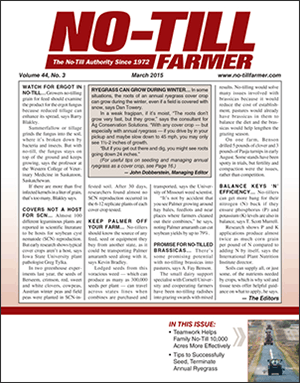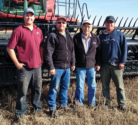Advertise Follow Us
No-Till Farmer

View Archived Issues
March 2015
Volume: 44
Edition: 3
Get full access NOW to the most comprehensive, powerful and easy-to-use online resource for no-tillage practices. Just one good idea will pay for your subscription hundreds of times over.
-
Table of Contents
Table of Contents
Digital Subscribers enjoy full access to No-Till Farmer's premium content. A paid subscription is required in order to read these stories.Are you a Premium or Digital subscriber? You enjoy:
- Unlimited access to all digital content here
- Freedom to view No-Till Farmer on all your devices
- Gleaning years of knowledge from the world's largest online library dedicated to no-till practices
Are you a Print only subscriber? Easily upgrade your subscription today! For only $10 more on a one year option, you gain the benefits of both the print edition delivered to your door and unlimited access to thousands of online pages of no-till content.
No-Tillers Build Better Practices at National No-Tillage Conference
From using cover crops to cycle nutrients to easing compaction with precision technology, no-tillers took home a bounty of no-till tips from the 23rd annual National No-Tillage Conference.Read More9 No-Till Planter Tips for Accurate, Consistent Seeding
Planter specialist Bill Lehmkuhl shares the key measurements and inspections no-tillers should perform on their no-till planters to ensure better seeding results and greater yields.Read MoreGetting Ready for Those Spring No-Till Challenges
Focusing on healthy soil, avoiding compaction and outfitting your no-till planter properly can help you overcome challenges with no-tilling in tough soils.Read MoreWhat I've Learned from No-TillingInheriting A Legacy of No-Till
With no-till long established by an innovator of the practice, the Hilton family in Alberta is free to focus on their business and the next big things.Read MoreStalk Roller Links Residue Breakdown with No-Till Benefits
Manufacturer says by sizing corn stalks into small-but-connected pieces, the 360 Chainroll can increase microbial activity through faster residue decomposition and create a ‘virgin’ seedbed.Read MoreClover, Cereal Rye Enhance No-Tiller’s 3-Year Rotation
Iowa no-tiller Joe Kriegel uses cereal rye and frost-seeded red clover in a rotation with corn and soybeans to reduce erosion, improve soil fertility and rescue heavily tilled fields.Read More8 Keys to Help No-Tillers Manage Annual Ryegrass
No-tillers just starting to use annual ryegrass should follow a few simple rules to take advantage of this cover crop’s compaction-busting, nitrogen-scavenging benefits.Read More -
Featured Articles
Featured Articles
What I've Learned from No-TillingInheriting A Legacy of No-Till
With no-till long established by an innovator of the practice, the Hilton family in Alberta is free to focus on their business and the next big things.Read More8 Keys to Help No-Tillers Manage Annual Ryegrass
No-tillers just starting to use annual ryegrass should follow a few simple rules to take advantage of this cover crop’s compaction-busting, nitrogen-scavenging benefits.Read More9 No-Till Planter Tips for Accurate, Consistent Seeding
Planter specialist Bill Lehmkuhl shares the key measurements and inspections no-tillers should perform on their no-till planters to ensure better seeding results and greater yields.Read More - Digital Edition
-
Online Extras
Online Extras
Stalk Roller Links Residue Breakdown with No-Till Benefits
Manufacturer says by sizing corn stalks into small-but-connected pieces, the 360 Chainroll can increase microbial activity through faster residue decomposition and create a ‘virgin’ seedbed.Read MoreProtect Soil, Produce More ‘N’ with Frost Seeded Red Clover
No-tillers raising winter wheat can use this time-honored practice to boost yields for the following crop, improve soil tilth and relieve compaction, all without hauling out a no-till planter or drill.Read More












